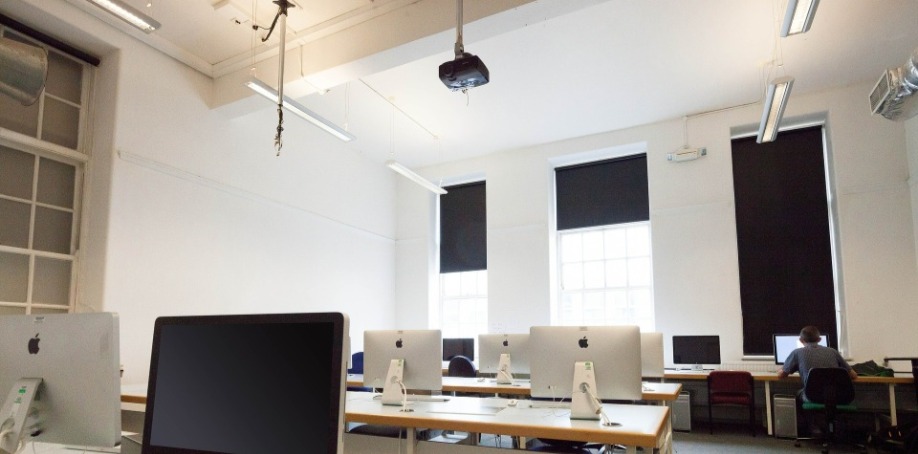
Universities are at the forefront of research and technology. Staying ahead ensures that those educational institutions are preparing the next generation to thrive.
Two of the most impactful technologies influencing innovation in education today are projection mapping and AV over IP. Here’s how higher education drives learning through the use of these cutting-edge tools.
Projection Mapping and Storytelling
Projection mapping is often considered an entertainment technology, used widely at conferences, festivals and concerts.
Still, the educational aspect of projection mapping shouldn’t be underestimated. As seen in a display presented by Penn State, projection mapping can be used to tell stories about a school’s history and culture. Led by Pearl Media, the projection was intended to launch a new initiative: to make Penn State as diverse and inclusive as possible.
This intention was successfully presented through an experience that highlighted historical photography to tell the story of Penn State throughout the years. By illustrating the history of Penn State, the imagery helped to create promise for a future of progress and equality.
In addition to using projection mapping as a storytelling tool, displays can help technology students learn about the technology itself. At Harrisburg University, a projection mapping display celebrated the school’s tenth anniversary. According to the university’s interactive media professor Charles Palmer, it display offers a number of benefits.
“The display serves a dual purpose since our students will be able to learn and master this technology by updating content through their classwork,” he explains. In addition to learning about the school’s origins, the display provided an opportunity for students to see a real-world version of a tool they would soon be covering in class.
Projection mapping is also used to educate students about current issues. An innovative scientific and social project was created from a collaboration between AV provider Christie Digital and Louisiana State University. The basis of the project was to educate students, teachers, scientists and the public about the encroaching impact of climate change on the Mississippi wetlands.
“We understand the physical model’s limits. It really only speaks to one thing, the Mississippi River’s ability to transport and divert sediment. But there are so many other things we analyze – storm surge, salinity changes, sea level rise; all the things that this model doesn’t necessarily analyze,” says Rudy Simoneaux, engineering division chief at the Coastal Protection and Restoration Authority of Louisiana.
The digital projection complements the physical model and provides a visually compelling explanation about a complex topic that affects local people and their natural resources.
Powering Learning and Distance Education
Technology has played an increasingly important role in education. From kindergarten to college, the ability to stream high-quality video and audio is moving from important to essential. According to Utelogy cofounder Scott McGarrigle, educational entities that fail to implement these capabilities risk falling behind.
“These classrooms of the future must be AV over IP-based to keep up with the trends in education, as this is the highway that allows interactive and collaborative learning and teaching to take place,” he explains.
AV over IP helps unite digital content from across mediums. Whether showing a YouTube video or accessing files in the cloud, AV over IP makes content more accessible to teachers and students on demand.
McGarrigle notes that the best way to install AV over IP in classrooms is to take a student-centric approach. This ensures that the implementation will support a wide variety of instructional models and learning abilities.
Take remote learning, for example. As the freelance and remote working economy grows, distance education is an increasingly in-demand functionality for education providers. AV over IP is an affordable way to leverage existing equipment to expand connection and connectivity, says Joe Fattorini, K12 education sales manager at Presentation Products.
"The idea of interactivity is no longer about touchscreens or SMART boards, but about using technology to connect students to teachers and other students as easily as they get to videos and information via Google."
In addition to establishing connections across campus and to students at home, AV over IP can help connect young learners across the globe, fostering meaningful educational and cultural exchanges.

Helping Universities Adapt and Grow
Universities are always changing and adapting to new technologies. AV over IP makes it easy for educational institutions to adopt new tools and offer state-of-the-art software and learning experiences for students, writes the team at Vantage Technology Group.
“As new features become available, they can be easily added to the system through software updates, with no impact on existing hardware or cabling and with minimal expense.”
This is in contrast to legacy AV systems, in which dedicated hardware performs specific functions. In order to scale up with a traditional AV systems, new hardware needs to be purchased and implemented.
Flexible technology allows universities to create adaptable learning environments for any subject being taught. Domenic Screnci, Ed.D., former senior advisor of academic and emerging technology at Boston University, says flexibility makes sense from a design and integration perspective.
“In some rooms at our university we have as many as 15 different instructors using that room over the course of a semester and they could be from Maths to Sociology to Physics to Psychology, so it's not like there's some homogeneous use of that room between all these disciplines, flexibility is the key,” he explains.
Major universities are already realizing the benefits of this technology. Dave Test, group leader of classroom technology at Penn State, points out why increased flexibility is such a selling point: "Having that flexibility of running all of your AV stuff over commodity network hardware and cable runs — that's something we're going to be evaluating as we develop new spaces and certainly as we take part in new building designs.”
Rather than investing in an expensive proprietary switching system, embracing the commodity network is a more efficient and cost-effective option, he says.

Understanding AV over IP in Action
One notable example can be seen at Mount Royal University in Calgary, Canada. At the university's new library and learning center, classrooms had to facilitate active learning experiences. The installation of AV over IP made it possible to create a wide variety of interactive teaching environments, says Paul Alegado, a technology consultant who worked on the project.
“Several student rooms can be combined or used separately in the new facility, and the university wanted a sustainable method of moving AV around the main room or each individual room to facilitate teaching,” he explains.
Another example comes from a research institute at the University of Toronto. After expanding the facility to improve outreach programs and boost community engagement, a new pavilion demanded high-quality audio and video. AV over IP equipment was installed to leverage existing IP infrastructure while providing high-quality video distribution that can be adapted to multiple displays throughout the center.
“We're able to do so much more with the system—even scaling the system for any future display and source additions—while meeting our high technology standards and budgetary restrictions,” says Kurt Binnie, director of information technology at the Lester B. Pearson school board in Montreal.
Now, the center can scale to meet the demands of large public assemblies, private programs and important presentations.
Images by: kasto/©123RF.com, STUX, Bruno Coelho/©123RF.com


